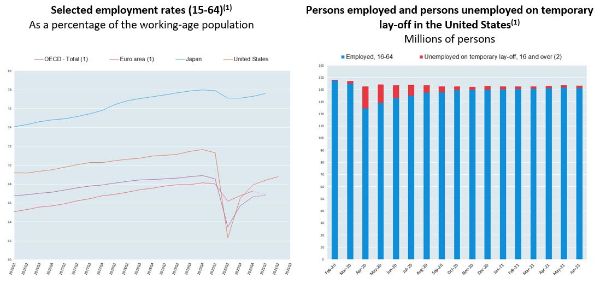OECD Area Employment Rate Rose To 66.8% In The First Quarter Of 2021, But Wide Disparities Across Countries Are Visible
The OECD area employment rate – the share of the working-age population with jobs – rose to 66.8% in the first quarter of 2021, from 66.7% in the previous quarter. Some care is needed in interpreting the latest developments in the OECD employment rate, as methodological changes to the EU Labour Force Survey blur the comparison between the fourth quarter of 2020 and the first quarter of 2021 for EU countries. In addition, a large part of the increase in the third and, to a lesser extent, fourth quarter of 2020 reflects the return to work of furloughed workers in Canada and the United States, where they are recorded as unemployed, whereas in most other countries, they are recorded as employed.
In the euro area, the employment rate stood at 66.9% in the first quarter of 2021, as compared to 68.4% in the United States and 77.6% in Japan. A large disparity is also observed within the area, with the employment rate ranging from a maximum of 79.3% in the Netherlands to a minimum of 53.9% in Greece.
See the full release.
See the tables and charts in Excel.

(1) Break in time series for the euro area between Q4 2020 and Q1 2021 resulting from changes in the EU Labour Force Survey. This break also affects, to some extent, aggregates for the OECD-Total. Visit the interactive OECD Data Portal to explore these data further. | (1) The chart provides a more comparable view of movements in US employment statistics with movements in most other OECD countries, where furloughed workers are included in official employment statistics. It should however not be interpreted as alternative official statistics for the United States. In this chart, the number of employed covers age group from 16 to 64, while the number of unemployed on temporary lay-off covers age group 16 and over. (2) US Current Population Survey data. |
In the United States, the increase continued to slow down as the number of furloughed workers returning to work diminished: the employment rate rose by 0.5 percentage point in the first quarter of 2021, to 68.4%, then by 0.4 percentage point, to 68.8% in the second quarter. In Canada, the employment rate increased in the first and second quarter of 2021, respectively by 0.1 percentage point to 72.1%, then by 0.3 percentage point, to 72.4%. In the first quarter of 2021, the employment rate increased in a majority of OECD countries outside the European Union, with the strongest increases (by 0.8 percentage point or more) observed in Chile (to 57.3%), Colombia (to 60.7%), Australia (to 74.3%) and Costa Rica (to 56.0%). The employment rate also increased (by 0.5 percentage point or less) in Mexico (to 59.5%), Japan (to 77.6%) and New Zealand (to 76.9%). By contrast, it continued to decline in Israel (by 0.5 percentage point, to 65.4%) and was stable in Korea (at 65.7%) and the United Kingdom (at 74.7%). In all these non-EU OECD countries, the employment rate in the first quarter of 2021 was lower than in the first quarter of 2020, with differences ranging from about 6.0 percentage points in Chile and Costa Rica to less than 0.5 percentage point in Australia and Japan.


 Gary M. Feinman, IMI: Archaeology Can Now Tell Us How People Have Muffled And Challenged Economic Inequality Across History
Gary M. Feinman, IMI: Archaeology Can Now Tell Us How People Have Muffled And Challenged Economic Inequality Across History CNS: Will All Children Be Born Free Of HIV, Syphilis And Hepatitis-B By 2030?
CNS: Will All Children Be Born Free Of HIV, Syphilis And Hepatitis-B By 2030? Save The Children: Sudan - One Child Every 10 Seconds Forced To Flee Their Home Since Conflict Began Two Years Ago
Save The Children: Sudan - One Child Every 10 Seconds Forced To Flee Their Home Since Conflict Began Two Years Ago People with Disability Australia - PWDA: People With Disability Invisible In Election Debates And Housing Promises
People with Disability Australia - PWDA: People With Disability Invisible In Election Debates And Housing Promises East West Center: NZ Deputy Prime Minister Recounts Longstanding US-NZ Relationship In The Pacific
East West Center: NZ Deputy Prime Minister Recounts Longstanding US-NZ Relationship In The Pacific Global Jews for Palestine: Jewish Organisations' Passover Statement, After 40 Days Of Starvation
Global Jews for Palestine: Jewish Organisations' Passover Statement, After 40 Days Of Starvation